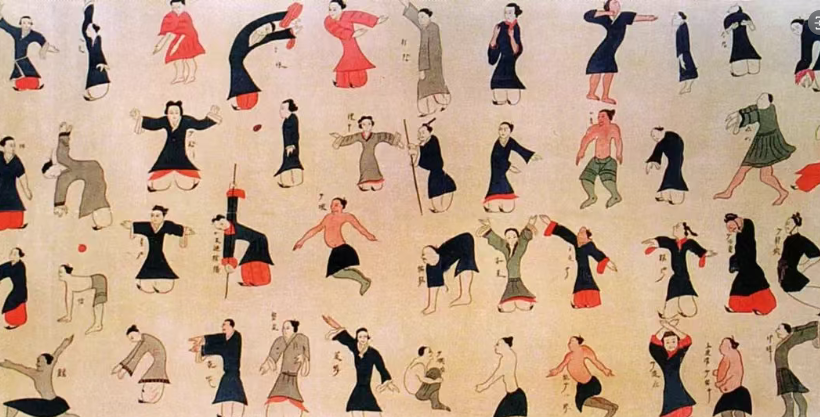There are many types of traditional sports regimen methods, which are divided into different categories according to their functions, genres, characteristics, etc.
(1) Classification according to efficacy
According to different effects, sports health can be divided into four types: guiding, spitting, pressing stilts, and martial arts.

1. Guidance
Guidance, also known as “Tao Guidance”, has the effect of promoting qi and blood, stretching limbs, and dispelling diseases, and induces and enlightens the inner potential of the human body through posture adjustment, breathing exercise, physical and mental relaxation, and mind concentration, and regulates and enhances the functions of various parts.
2. Spit
It is a technique of refining qi in qigong, which refers to exhaling the turbid qi in the chest from the mouth, and then slowly inhaling fresh qi from the nose. There are dynamic and static formulas, and the commonly used ones are six-character formulas, twelve-character formulas, etc.
3. Press the stilts
Stilts are also known as massage. “Su Wen” notes that “according to the said to press the skin and meat, the stilt is to raise the hands and feet”, indicating that the stilt includes massage and limb movement, which is used to prevent and treat diseases. There are two types of massage: self-massage and other people’s massage.
4. Martial arts
Wushu, also known as national martial arts or martial arts, is a variety of offensive and defensive fighting kung fu, routines and single posture exercises that form bare hands or instruments according to the rules of kicking, hitting, falling, holding, falling, hitting, splitting, stabbing and other actions. (2) Classification by genre
According to the different schools of sports and health preservation, it is divided into five types: Buddhism, Taoism, Confucianism, medicine, and folk fitness.
1. Buddhist fitness
The purpose is to cultivate spiritual liberation and purification of the soul. The three learnings of precepts, concentration, and wisdom are to achieve the highest state of fitness and cultivation on the basis of Buddhist physical and mental cultivation, such as zazen.
2. Taoist fitness techniques
He advocates “Taoism and Nature” and “Silence and Inaction”. Commonly used methods such as guidance and breathing have the effect of cultivating the Tao and cultivating longevity.
3. Confucian fitness
Pay attention to sitting and forgetting, with the purpose of meditation, self-cultivation, and qi cultivation, such as sitting and forgetting.
4. Doctor’s fitness
The “Yellow Emperor’s Neijing” records five kinds of medical methods, namely stones, poisons, moxibustion, nine needles, guiding stilts, as well as relaxation, internal nourishment, strengthening, five poultry plays, and health care in the health exercises.
5. Folk fitness
The method is simple, and there are small exercises such as walking and shuttlecock kicking, as well as sports with a large amount of exercise, such as skipping rope and mountaineering. (3) Classification according to the mode of exercise
According to the way of exercise, exercise health can be divided into two types: dynamic work and static work.
1. Kinetic work
Exercise is a method of combining mental activity, breathing adjustment, and limb movements. It is characterized by external movement and internal quietness, and seeking tranquility in movement, such as Taijiquan, Baduanjin, Wufowl Opera, etc.
2. Jinggong
Meditation is a method of standing, sitting, lying and other outwardly static postures in conjunction with mental activities and various high-speed breathing methods. It is characterized by external static and internal movement, and movement in stillness, such as standing pile work, internal cultivation work, sitting meditation, etc.
